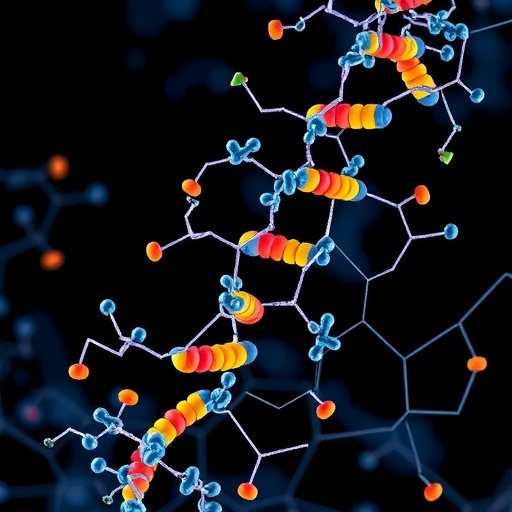
In a groundbreaking leap for genetic engineering, scientists have unveiled a new generation of mitochondrial DNA (mtDNA) base editors that vastly outperform their predecessors in both efficiency and precision. Traditionally, A-to-G base editing within mitochondria—a powerhouse of the cell critical for energy production—has been beset by low efficiency and limited targeting capability, hindering both basic research and the development of therapies for mitochondrial diseases. Now, through the power of directed evolution, researchers have engineered enhanced TadA-8e-based adenine base editors that not only exhibit remarkably increased editing activity but also display an expanded range of sequence contexts amenable to editing. This development stands to revolutionize the mitochondrial genetics field and open new avenues for modeling and potentially treating mitochondrial disorders.
Mitochondria, containing their own distinct DNA, play a pivotal role in cell metabolism and energy conversion. Mutations in mtDNA are implicated in a broad spectrum of human diseases, ranging from neurodegenerative disorders to metabolic syndromes. However, precise manipulation of mtDNA has long eluded scientists due to the inherent challenges in delivering genetic tools to mitochondria and the technical limitations of existing editing methodologies. Conventional mitochondrial base editors primarily rely on the split DddA deaminase linked to transcription activator-like effectors (TALEs). While these editors have provided proof-of-concept, their practical utility has been severely constrained by suboptimal editing efficiencies and a narrow scope of editable sequence contexts.
This transformative study presents an innovative class of engineered mitochondrial adenine base editors, termed eTd-mtABEs, derived from a reimagined cytosine deaminase scaffold. These advanced editors capitalize on highly evolved variants of the TadA-8e enzyme, which have been subjected to rigorous directed evolution to optimize their catalytic performance and substrate recognition. The result is a mitochondrial base editor capable of executing A-to-G transitions with editing efficiencies reaching up to an unprecedented 87% in human cellular models. Such high-efficiency editing heralds a new era in mitochondrial genome engineering, enabling researchers to precisely and efficiently recode mitochondrial sequences that were previously refractory to modification.
.adsslot_H40faAbXsp{ width:728px !important; height:90px !important; }
@media (max-width:1199px) { .adsslot_H40faAbXsp{ width:468px !important; height:60px !important; } }
@media (max-width:767px) { .adsslot_H40faAbXsp{ width:320px !important; height:50px !important; } }
ADVERTISEMENT
Beyond simply improving efficiency, the eTd-mtABEs demonstrate a remarkable expansion in targeting compatibility, especially within previously disfavored nucleotide contexts. This broadening of sequence scope significantly enhances the versatility of the editors, facilitating mutation installation at a wider array of genomic loci critical for understanding mitochondrial function and disease. Importantly, the engineered editors maintain exceptional specificity, showcasing drastically reduced off-target effects at both DNA and RNA levels. Minimizing off-target editing is crucial for therapeutic applications, where precision ensures safety and helps prevent inadvertent deleterious mutations.
A key innovation in these editors is the substitution of the traditionally used DddA deaminase with DNA nickases within the eTd-mtABE backbone. This strategic replacement results in strand-selective A-to-G editing that is enhanced on average 3.2-fold, underscoring the functional advantages conferred by the nickase architecture over conventional double-strand base editors. This not only boosts editing efficiencies but also reduces the risk of introducing deleterious double-stranded DNA breaks, a common concern that can lead to genomic instability or cytotoxicity.
The profound potency of the eTd-mtABEs is further demonstrated in an in vivo rat model, where editing efficiencies soared up to 145-fold higher compared to the benchmark split DddA TALE-linked deaminase tool. This remarkable improvement establishes eTd-mtABEs as a premier platform for mitochondrial genome manipulation in mammalian systems, thus opening the door for generating animal models with precise mitochondrial mutations. These models are indispensable for exploring disease mechanisms and therapeutic interventions in a physiologically relevant context.
Capitalizing on this enhanced platform, the research team succeeded in generating sensorineural hearing loss rat models by introducing targeted pathogenic mutations through embryonic injection of eTd-mtABEs. The mutational frequencies achieved in these animals reached up to 44%, showcasing not only the efficiency of the editor but also its applicability in producing heritable mitochondrial disease models. Such in vivo proof-of-concept lays vital groundwork for future mitochondrial gene therapy approaches aiming to correct deleterious mutations underlying human pathologies.
A notable aspect of this study is the refined balance achieved between editing efficiency and specificity. Often, increasing the activity of a genome editor comes at the cost of elevated off-target mutations, which can imperil translational applications. Through meticulous enzyme engineering and the strategic use of DNA nickases, the eTd-mtABEs exhibit markedly subdued off-target editing footprints, both in mitochondrial DNA and cellular RNA transcripts. This precision bodes well for future therapeutic deployment and regulatory approval pathways.
Furthermore, the expansion of editable sequence contexts extends the reach of base editing beyond the canonical protospacer adjacent motif (PAM)-dependent spacers, ameliorating one of the major limitations that hampered efficient targeting in mitochondrial genetic engineering. The newly discovered TadA-8e variants show compatibility with a diverse array of nucleotides surrounding the target adenine, which facilitates broader application across various mtDNA loci implicated in human disorders.
From a mechanistic perspective, the authors effectively demonstrate that replacing DddA, an established double-stranded DNA cytidine deaminase, with nickase-mediated strand-specific editing not only improves efficiency but also contributes to the low off-target profile. This suggests new paradigms in mitochondrial DNA editing design where precision base editing circumvents the collateral damage often associated with double-stranded DNA enzymatic activities.
The implications of this technology cascade beyond the generation of disease models, with tangible potential for therapeutic mitochondrial gene editing. Given the central role played by mitochondria in cellular metabolism and apoptosis, correcting pathogenic variants in mtDNA could revolutionize the treatment landscape for a range of incurable mitochondrial diseases. The eTd-mtABEs, with their newfound effectiveness and specificity, could drive forward efforts to realize safe and efficacious mitochondrial gene therapies.
Moreover, the successful demonstration of high-efficiency editing in rat embryos heralds opportunities for developmental biology studies that probe mitochondrial inheritance and function across organismal lifespans. By enabling precise manipulation at early developmental stages, these editors facilitate detailed exploration of mitochondrial genetics at physiologically meaningful scales, unveiling insights into heteroplasmy dynamics and mutation propagation.
In conclusion, the engineered eTd-mtABEs represent a monumental advancement in the field of mitochondrial biology and genome engineering. They combine state-of-the-art enzyme evolution, novel DNA nickase strategies, and an acute focus on precision to deliver a toolset that eclipses previous mitochondrial base editors in efficacy and accuracy. This breakthrough paves the way not only for unprecedented basic research into mitochondrial function and pathology but also for the development of transformative therapeutic approaches targeting the mitochondrial genome — a frontier that has long resisted genetic manipulation.
As the tools of mitochondrial DNA editing continue to evolve, the work by Chen, Hong, Luan, and colleagues marks a pivotal moment, elevating mitochondrial genetic engineering from a niche technological challenge into a broadly applicable and highly precise molecular toolkit. Their findings illuminate a path forward for tackling mitochondrial diseases with genetic precision and unlock a wealth of possibilities for synthetic biology, disease modeling, and regenerative medicine.
The expansive potential of eTd-mtABEs promises to catalyze a renaissance in mitochondrial research, with the promise that one day inherited mitochondrial diseases may be repaired or prevented at their genetic root. Future investigations will undoubtedly build upon these foundational discoveries to refine these editors further, optimize delivery systems, and translate these advances from experimental models to clinical reality.
Subject of Research:
Article Title:
Article References:
Chen, L., Hong, M., Luan, C. et al. Efficient mitochondrial A-to-G base editors for the generation of mitochondrial disease models. Nat Biotechnol (2025). https://doi.org/10.1038/s41587-025-02685-x
Image Credits: AI Generated
Tags: A-to-G base editorschallenges in mitochondrial gene therapydirected evolution in geneticsefficient mitochondrial DNA editingenergy production in cellsgenetic engineering advancementsmitochondrial disease therapiesmitochondrial genetics revolutionmodeling mitochondrial disordersmtDNA mutation implicationsprecision editing in mitochondriaTadA-8e-based editing



